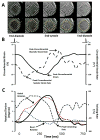Diastolic dysfunction in women with signs and symptoms of ischemia in the absence of obstructive coronary artery disease: a hypothesis-generating study
- PMID: 24633782
- PMCID: PMC4031259
- DOI: 10.1161/CIRCIMAGING.114.001714
Diastolic dysfunction in women with signs and symptoms of ischemia in the absence of obstructive coronary artery disease: a hypothesis-generating study
Abstract
Background: Angina, in the absence of obstructive coronary artery disease, is more common in women, is associated with adverse cardiovascular morbidity and mortality, and is a major burden to the healthcare system. Although advancements have been made to understand the mechanistic underpinning of this disease, the functional consequence remains unclear.
Methods and results: Cardiac magnetic resonance imaging was performed to assess left ventricular function in 20 women with signs and symptoms of ischemia, but no obstructive coronary artery disease (cases), and 15 age- and body mass index-matched reference controls. Functional imaging included standard cinematic imaging to assess left ventricular morphology and global function, along with tissue tagging to assess left ventricular tissue deformation. Systolic function was preserved in both cases and controls, with no differences in ejection fraction (mean±SE: 63.1±8% versus 65±2%), circumferential strain (-20.7±0.6% versus -21.9±0.5%), or systolic circumferential strain rate (-105.9±6.1% versus -109.0±3.8% per second). In contrast, we observed significant differences between cases and controls in diastolic function, as demonstrated by reductions in both diastolic circumferential strain rate (153.8±8.9% versus 191.4±8.9% per second; P<0.05) and peak rate of left ventricular untwisting (-99.4±8.0° versus -129.4±12.8° per second; P<0.05).
Conclusions: Diastolic function is impaired in women with signs and symptoms of ischemia in the absence of coronary artery disease, as assessed by cardiac magnetic resonance tissue tagging. These results are hypothesis-generating. Larger studies are needed to define the exact mechanism(s) responsible and to establish viable treatment strategies.
Keywords: diastole; magnetic resonance imaging; myocardial ischemia; women.
© 2014 American Heart Association, Inc.
Conflict of interest statement
The authors have no conflicts to disclose.
Figures


Comment in
-
Diastolic dysfunction in patients with ischemic symptoms without obstructive coronary artery disease.Circ Cardiovasc Imaging. 2014 May;7(3):420-1. doi: 10.1161/CIRCIMAGING.114.001984. Circ Cardiovasc Imaging. 2014. PMID: 24847007 No abstract available.
References
-
- Shaw LJ, Merz CNB, Pepine CJ, Reis SE, Bittner V, Kelsey SF, Olson M, Johnson BD, Mankad S, Sharaf BL, Rogers WJ, Pohost GM, Sopko G Women’s Ischemia Syndrom Evaluation (WISE) Investigators. The Economic Burden of Angina in Women With Suspected Ischemic Heart Disease: Results From the National Institutes of Health National Heart, Lung, and Blood Institute-Sponsored Womens Ischemia Syndrome Evaluation. Circulation. 2006;114:894–904. - PubMed
-
- Bairey Merz CN, Kelsey SF, Pepine CJ, Reichek N, Reis SE, Rogers WK, Sharaf BL, Sopko G. The Womens Ischemia Syndrome Evaluation (WISE) Study: protocol design, methodology and feasibility report. J Am Coll Cardiol. 1999;33:1453–1461. - PubMed
-
- Buchthal SD, den Hollander JA, Merz CNB, Rogers WJ, Pepine CJ, Reichek N, Sharaf BL, Reis S, Kelsey SF, Pohost GM. Abnormal Myocardial Phosphorus-31 Nuclear Magnetic Resonance Spectroscopy in Women with Chest Pain but Normal Coronary Angiograms. N Eng J Med. 2000;342:829–835. - PubMed
-
- Reis SE, Holubkov R, Lee JS, Sharaf B, Reichek N, Rogers WJ, Walsh EG, Fuisz AR, Kerensky R, Detre KM, Sopko G, Pepine CJ. Coronary flow velocity response to adenosine characterizes coronary microvascular function in women with chest pain and no obstructive coronary disease: Results from the pilot phase of the Womens Ischemia Syndrome Evaluation (WISE) Study. J Am Coll Cardiology. 1999;33:1469–1475. - PubMed
Publication types
MeSH terms
Substances
Grants and funding
- T32 HL116273/HL/NHLBI NIH HHS/United States
- N01 HV068161/HV/NHLBI NIH HHS/United States
- N01 HV068163/HL/NHLBI NIH HHS/United States
- R03 AG032631/AG/NIA NIH HHS/United States
- 1R03AG032631/AG/NIA NIH HHS/United States
- U01 HL649141/HL/NHLBI NIH HHS/United States
- U01 HL649241/HL/NHLBI NIH HHS/United States
- M01 RR000425/RR/NCRR NIH HHS/United States
- N01 HV068162/HL/NHLBI NIH HHS/United States
- K23 HL105787/HL/NHLBI NIH HHS/United States
- U0164829/PHS HHS/United States
- U01 HL064829/HL/NHLBI NIH HHS/United States
- T32 HL069751/HL/NHLBI NIH HHS/United States
- T32HL69751/HL/NHLBI NIH HHS/United States
- N01-HV-68162/HV/NHLBI NIH HHS/United States
- N01 HV068164/HV/NHLBI NIH HHS/United States
- N01 HV068163/HV/NHLBI NIH HHS/United States
- N01-HV-68163/HV/NHLBI NIH HHS/United States
- MO1-RR00425/RR/NCRR NIH HHS/United States
- K23HL105787/HL/NHLBI NIH HHS/United States
LinkOut - more resources
Full Text Sources
Other Literature Sources
Medical

